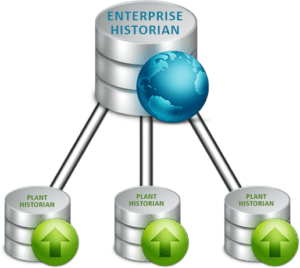Historian systems have seen a rapid increase in use throughout various industries in the past decade or so. Data Historians improve how manufacturers, continuous process plant and utilities operate and manage their assets efficiently. Data Historian systems were built with the specific purpose of acquiring instrumentation data used in operational control, aiding in supervisory capacities, quality assurance, and performance monitoring. In more modern times, Operational Historians and Enterprise Historians can help machine learning applications that require historical data to form an operational signature from which intelligent decisions, anomaly detection and machine learning is derived.
But what is the difference between Operational and Enterprise Historians?
Introduction
Operational Historian is a term used in reference to high performance process database applications used for operational process data, hence “operational” in the name. Generally, the Operational Historian is collocated at the plant with other control system components including instrumentation and SCADA. There is always a need to have better capabilities from the standpoint of data capture, compression, validation, and aggregation. As such, historian software is built-in or used together with control systems like a DCS and PLCs.
An Operational Historian manages data regarding processes and production, with its main role consisting of efficient storing of process data.
An Enterprise Historian is generally located in a central office, data centre or other location other than the production facility. The Enterprise Historian is the data provider to a much wider user base than typical for an Operational Historian. Sometimes these terms may be confusing because much, if not all of the data in the Operational Historian may also appear in the Enterprise Historian, particularly in situations where a multi-tier configuration is used. Many organisations also collect data from other sources other than operational data and aggregate all information in the Enterprise Historian.

Basically, Operational Historians are used at the operator level while Enterprise Historians are used at the business level for planners, designers, managers and other stakeholders. The Enterprise Historian user base is generally very large, and the performance of Enterprise Historians is significantly more demanding than that required for localized Operational (production only) Historians.
Operational Support Variations
In terms of operational support, historical data is normally collected at a supervisory level. The operational support dimension shows the first key difference between Operational Historians and Enterprise Historians, wherein Operational Historians are used mainly for supervisory purposes and analyzing plant or production performance in terms of real time operations. People who use them are engineers and operators, and they collect instrumentation and control system data.
In many circumstances, the Enterprise Historians only collects a subset of that captured by the Operational Historian. This is more commonplace when the Enterprise Historian uses lower performance technology, ie only suitable for plant and operational application workloads.
Of course, data must be reliably acquired with precision and “at speed”. Usually, the Operational Historian communicated directly with the Enterprise Historian without any reduction in data quality. Sometimes, Enterprise Historians collect information from plant in parallel to the Operational Historian providing an independent data pathway and data warehouse. On the other hand, the Enterprise Historian is generally the gateway to provide service bus access to Enterprise Resource Planning (ERP), Enterprise Asset Management (EAM) and Supply Chain Management (SCM) systems. The Enterprise Historian is the ideal gateway or interface from a cybersecurity standpoint thus isolating by design IT and OT systems yet providing essential information to any users who may contribute to operating, designing or managing the business more effectively.
Differences in Data Access
The question of data access is more related to levels of security and permissions than the technology itself. At an operational level, to ensure operational integrity, access to any operational data is generally restricted and managed by an elite group of users. This ensures that no matter what happens, the business can most like still operate its assets without interference.
Depending on the choice of Operational Historian, users may be able to use very rich and complex analysis tools, included anomaly detection, complex reporting tools and calculations, however, the use of client tools are more determined by (1) the choice of software application and (2) the permissions granted by the business in terms of access to client tools and access to sensitive data.
A Process Historians or Data Historians (a more generic term again) primary purpose is to store data with its operational time stamp providing a long-term data storage warehouse. There are various types of storage variables and for tier one historians the data is stored in highly efficient compressed files.
Access to data historian raw data may be via industry standards such as OPC HDA, SQL, REST API. These types of interfaces are enterprise in nature and are used for system-to-system connectivity. Access to these interfaces is usually restricted by licensing and tightly managed in terms of security and user/system access.
Specific Advantages
Operational Historians boast some overt advantages, like data acquisition redundancy, a speedy data collection, and elimination of system noise over that provided by typical SCADA systems. An Enterprise Historian offers the same performance capability however by design the information it serves out to users and other systems is generally more holistic and tailored to how the business operates its assets.
Conclusion
There are differences between an Operational Historian and an Enterprise Historian. The fundamental differences are determined by the design of the system and perhaps the choice of the product to be used. Operational Historians and Enterprise Historians both provide specific capability for a boundless range of industries.
Sources:
http://software.schneider-electric.com/pdf/white-paper/myths-about-historians/

YOU MIGHT ALSO BE INTERESTED IN:
Next Generation Historians
Our top 5 problems with Process Historians
